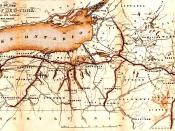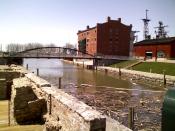Back in the early 1700's a French engineer named Vauban suggested that a canal should be built to link the rivers and lakes of New York State. Years later this idea was looked upon repeatedly when the Western Inland Locks Navigation Company established a system of travel by use of canals (Shaw, 59). Although the company was ultimately defeated, the initial idea of canals and locks was soon to be redeveloped. By the mid-1800's, with a lot of hard work, sweat, and tears, the Erie Canal became the foremost route for trade, travel, and immigration to the new western lands.
The Western Inland Locks Navigation Company was the initial cause and creation leading to the construction of the Erie Canal. In the later years of the 1700's the goal of the company was to create an uninterrupted route of transportation from the Hudson River to Lake Ontario for which trading could transpire.
The accomplishment for the attempt to link these two major bodies of water in New York State was a one mile canal that bypassed the falls at Little Falls, New York, along the Mohawk River (Shaw, 46). Ultimate failure caused the company to go bankrupt because they could not afford to keep the locks up and running in competent conditions even though tolls were collected to help compensate for construction costs (Shaw, 100). Although there was evident failure of the Western Inland Locks Navigation Company, their attempts at linking waterways allowed political and commercial leaders to call for New York State to build a canal system neighboring the eastern and western halves of New York.
In 1817, Governor Dewitt Clinton of New York State convinced the New York State legislature to fund $7 million dollars for the construction of the Erie Canal. On July 4, 1817, in Rome,



Erie Canal
This is an interesting, well-researched essay that is terribly poorly written. If you rewrite it to use propoer English, you will have a very good essay.
3 out of 3 people found this comment useful.